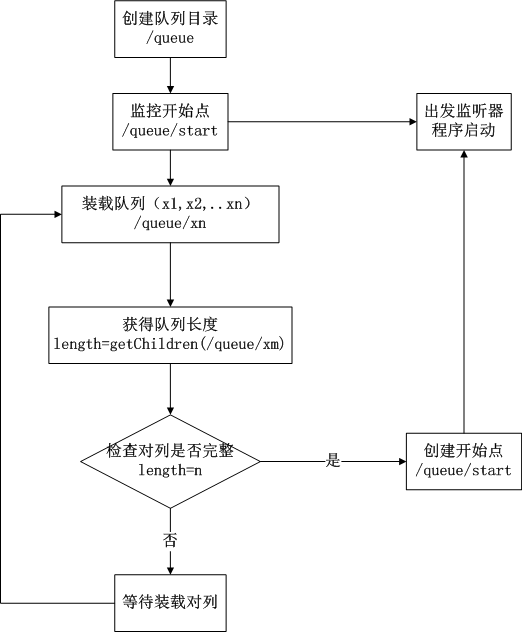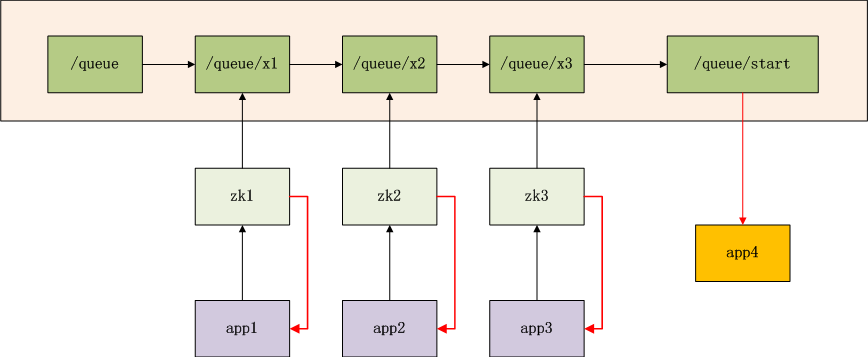ZooKeeper实现分布式队列Queue
让Hadoop跑在云端系列文章,介绍了如何整合虚拟化和Hadoop,让Hadoop集群跑在VPS虚拟主机上,通过云向用户提供存储和计算的服务。
现在硬件越来越便宜,一台非品牌服务器,2颗24核CPU,配48G内存,2T的硬盘,已经降到2万块人民币以下了。这种配置如果简单地放几个web应用,显然是奢侈的浪费。就算是用来实现单节点的hadoop,对计算资源浪费也是非常高的。对于这么高性能的计算机,如何有效利用计算资源,就成为成本控制的一项重要议题了。
通过虚拟化技术,我们可以将一台服务器,拆分成12台VPS,每台2核CPU,4G内存,40G硬盘,并且支持资源重新分配。多么伟大的技术啊!现在我们有了12个节点的hadoop集群, 让Hadoop跑在云端,让世界加速。
关于作者:
- 张丹(Conan), 程序员Java,R,PHP,Javascript
- weibo:@Conan_Z
- blog: http://blog.fens.me
- email: bsspirit@gmail.com
转载请注明出处: http://blog.fens.me/zookeeper-queue 
前言 ZooKeeper是一个分步式的协作系统,何为协作,ZooKeeper价值又有何体现。通过这篇文章的分布式队列的案例,你将了解到ZooKeeper的强大。关于ZooKeeper的基本使用,请参考:ZooKeeper伪分步式集群安装及使用
目录
- 分布式队列
- 设计思路
- 程序实现
1. 分布式队列
队列有很多种产品,大都是消息系统所实现的,像ActiveMQ,JBossMQ,RabbitMQ,IBM-MQ等。分步式队列产品并不太多,像Beanstalkd。
本文实现的分布式对列,是基于ZooKeeper现实的一种同步的分步式队列,当一个队列的成员都聚齐时,这个队列才可用,否则一直等待所有成员到达。
2. 设计思路
创建一个父目录 /queue,每个成员都监控(Watch)标志位目录/queue/start 是否存在,然后每个成员都加入这个队列,加入队列的方式就是创建 /queue/x(i)的临时目录节点,然后每个成员获取 /queue 目录的所有目录节点,也就是 x(i)。判断 i 的值是否已经是成员的个数,如果小于成员个数等待 /queue/start 的出现,如果已经相等就创建 /queue/start。
图标解释
- app1,app2,app3,app4是4个独立的业务系统
- zk1,zk2,zk3是ZooKeeper集群的3个连接点
- /queue,是znode的队列,假设队列长度为3
- /queue/x1,是znode队列中,1号排对者,由app1提交,同步请求,app1挂载等待
- /queue/x2,是znode队列中,2号排对者,由app2提交,同步请求,app2挂起等待
- /queue/x3,是znode队列中,3号排对者,由app3提交,同步请求,app3挂起等待
- /queue/start,当znode队列中满了,触发创建开始节点
- 当/qeueu/start被创建后,app4被启动,所有zk的连接通知同步程序(红色线),队列已完成,所有程序结束
注:
- 1). 创建/queue/x1,/queue/x2,/queue/x3没有前后顺序,提交后程序就同步挂起。
- 2). app1可以通过zk2提交,app2也可通过zk3提交
- 3). app1可以提交3次请求,生成x1,x2,x3使用队列充满
- 4). /queue/start被创建后,zk1会监听到这个事件,再告诉app1,队列已完成!
3. 程序实现
1). 单节点模拟实验
模拟app1,通过zk1,提交3个请求
public static void doOne() throws Exception {
String host1 = "192.168.1.201:2181";
ZooKeeper zk = connection(host1);
initQueue(zk);
joinQueue(zk, 1);
joinQueue(zk, 2);
joinQueue(zk, 3);
zk.close();
}
创建一个与服务器的连接
public static ZooKeeper connection(String host) throws IOException {
ZooKeeper zk = new ZooKeeper(host, 60000, new Watcher() {
// 监听/queue/start创建的事件
public void process(WatchedEvent event) {
if (event.getPath() != null && event.getPath().equals("/queue/start") && event.getType() == Event.EventType.NodeCreated) {
System.out.println("Queue has Completed.Finish testing!!!");
}
}
});
return zk;
}
出始化队列
public static void initQueue(ZooKeeper zk) throws KeeperException, InterruptedException {
System.out.println("WATCH => /queue/start");
zk.exists("/queue/start", true);
if (zk.exists("/queue", false) == null) {
System.out.println("create /queue task-queue");
zk.create("/queue", "task-queue".getBytes(), Ids.OPEN_ACL_UNSAFE, CreateMode.PERSISTENT);
} else {
System.out.println("/queue is exist!");
}
}
增加队列节点
public static void joinQueue(ZooKeeper zk, int x) throws KeeperException, InterruptedException {
System.out.println("create /queue/x" + x + " x" + x);
zk.create("/queue/x" + x, ("x" + x).getBytes(), Ids.OPEN_ACL_UNSAFE, CreateMode.EPHEMERAL_SEQUENTIAL);
isCompleted(zk);
}
检查队列是否完整
public static void isCompleted(ZooKeeper zk) throws KeeperException, InterruptedException {
int size = 3;
int length = zk.getChildren("/queue", true).size();
System.out.println("Queue Complete:" + length + "/" + size);
if (length >= size) {
System.out.println("create /queue/start start");
zk.create("/queue/start", "start".getBytes(), Ids.OPEN_ACL_UNSAFE, CreateMode.EPHEMERAL);
}
}
启动函数main
public static void main(String[] args) throws Exception {
doOne();
}
运行结果:
WATCH => /queue/start
/queue is exist!
create /queue/x1 x1
Queue Complete:1/3
create /queue/x2 x2
Queue Complete:2/3
create /queue/x3 x3
Queue Complete:3/3
create /queue/start start
Queue has Completed.Finish testing!!!
完全符合我的们预期。接下来我们看分布式环境
2). 分布式模拟实验
模拟app1通过zk1提交x1,app2通过zk2提交x2,app3通过zk3提交x3
public static void doAction(int client) throws Exception {
String host1 = "192.168.1.201:2181";
String host2 = "192.168.1.201:2182";
String host3 = "192.168.1.201:2183";
ZooKeeper zk = null;
switch (client) {
case 1:
zk = connection(host1);
initQueue(zk);
joinQueue(zk, 1);
break;
case 2:
zk = connection(host2);
initQueue(zk);
joinQueue(zk, 2);
break;
case 3:
zk = connection(host3);
initQueue(zk);
joinQueue(zk, 3);
break;
}
}
注:
- 1). 为了简单起见,我们没有增加复杂的多线程控制的机制。
- 2). 没有调用zk.close()方法,也就是说,app1执行完单独的提交,app1就结束了,但zk1还存在着,所以/queue/x1存在于队列。
- 3). 程序启动方法,分3次启动,命令行传不同的参数,分别是1,2,3
执行app1–>zk1
#日志输出
WATCH => /queue/start
/queue is exist!
create /queue/x1 x1
Queue Complete:1/3
#zookeeper控制台
[zk: 192.168.1.201:2181(CONNECTED) 4] ls /queue
[x10000000011]
执行app2–>zk2
#日志输出
WATCH => /queue/start
/queue is exist!
create /queue/x2 x2
Queue Complete:2/3
#zookeeper控制台
[zk: 192.168.1.201:2181(CONNECTED) 5] ls /queue
[x20000000012, x10000000011]
执行app3–>zk3
#日志输出
WATCH => /queue/start
/queue is exist!
create /queue/x3 x3
Queue Complete:3/3
create /queue/start start
Queue has Completed.Finish testing!!!
#zookeeper控制台
[zk: 192.168.1.201:2181(CONNECTED) 6] ls /queue
[x30000000016, x10000000014, start, x20000000015]
/queue/stats被建立,打印出“Queue has Completed.Finish testing!!!”,代表调用app4完成!
我们完成分布式队列的实验,由于时间仓促。文字说明及代码难免有一些问题,请发现问题的同学帮忙指正。
下面贴一下完整的代码:
package org.conan.zookeeper.demo;
import java.io.IOException;
import org.apache.zookeeper.CreateMode;
import org.apache.zookeeper.KeeperException;
import org.apache.zookeeper.WatchedEvent;
import org.apache.zookeeper.Watcher;
import org.apache.zookeeper.ZooKeeper;
import org.apache.zookeeper.ZooDefs.Ids;
public class QueueZooKeeper {
public static void main(String[] args) throws Exception {
if (args.length == 0) {
doOne();
} else {
doAction(Integer.parseInt(args[0]));
}
}
public static void doOne() throws Exception {
String host1 = "192.168.1.201:2181";
ZooKeeper zk = connection(host1);
initQueue(zk);
joinQueue(zk, 1);
joinQueue(zk, 2);
joinQueue(zk, 3);
zk.close();
}
public static void doAction(int client) throws Exception {
String host1 = "192.168.1.201:2181";
String host2 = "192.168.1.201:2182";
String host3 = "192.168.1.201:2183";
ZooKeeper zk = null;
switch (client) {
case 1:
zk = connection(host1);
initQueue(zk);
joinQueue(zk, 1);
break;
case 2:
zk = connection(host2);
initQueue(zk);
joinQueue(zk, 2);
break;
case 3:
zk = connection(host3);
initQueue(zk);
joinQueue(zk, 3);
break;
}
}
// 创建一个与服务器的连接
public static ZooKeeper connection(String host) throws IOException {
ZooKeeper zk = new ZooKeeper(host, 60000, new Watcher() {
// 监控所有被触发的事件
public void process(WatchedEvent event) {
if (event.getType() == Event.EventType.NodeCreated && event.getPath().equals("/queue/start")) {
System.out.println("Queue has Completed.Finish testing!!!");
}
}
});
return zk;
}
public static void initQueue(ZooKeeper zk) throws KeeperException, InterruptedException {
System.out.println("WATCH => /queue/start");
zk.exists("/queue/start", true);
if (zk.exists("/queue", false) == null) {
System.out.println("create /queue task-queue");
zk.create("/queue", "task-queue".getBytes(), Ids.OPEN_ACL_UNSAFE, CreateMode.PERSISTENT);
} else {
System.out.println("/queue is exist!");
}
}
public static void joinQueue(ZooKeeper zk, int x) throws KeeperException, InterruptedException {
System.out.println("create /queue/x" + x + " x" + x);
zk.create("/queue/x" + x, ("x" + x).getBytes(), Ids.OPEN_ACL_UNSAFE, CreateMode.EPHEMERAL_SEQUENTIAL);
isCompleted(zk);
}
public static void isCompleted(ZooKeeper zk) throws KeeperException, InterruptedException {
int size = 3;
int length = zk.getChildren("/queue", true).size();
System.out.println("Queue Complete:" + length + "/" + size);
if (length >= size) {
System.out.println("create /queue/start start");
zk.create("/queue/start", "start".getBytes(), Ids.OPEN_ACL_UNSAFE, CreateMode.EPHEMERAL);
}
}
}


